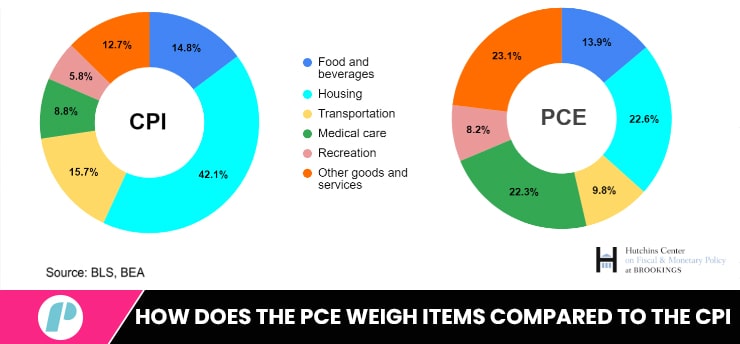
Introduction
Amongst others, the two most commonly used methods to calculate inflation are the CPI and the PCE. Although different from each other, both methods consist in periodically comparing prices within a certain sample group of products and services.
Whilst a yearly price increase (inflation) of 2% is considered ideal, a decrease in prices (deflation) is seldom seen as a positive sign for the economy.
In this article, we aim to examine CPI and PCEPI a little further and to find out why, while the Government looks at one, the FED chooses to look at the other.
Measuring inflation: weight and scope
Both the CPI (Consumer Price Index) and the PCE (Personal Consumption Expenditure) attempt to estimate inflation levels by comparing prices in a basket of goods and services purchased by the urban population (which in the US is equal to just over 80% of citizens), over a period of time.
As a trader and a market participant, you may have realized that, despite the common objective, the BLS (Bureau of Labour Statistics)’s CPI and the BEA (Bureau of Economic Analysis)’s PCE produce inflation level estimates that can differ and, sometimes, can do so significantly.
This is due to the fact that CPI and PCE are calculated in different ways, especially concerning weight and scope.

As the BLS itself explains on its own website:
“The weight effect is a result of differences in how consumer expenditure data are sourced. CPI sources data from consumers, while PCE sources from businesses. The scope effect is a result of the different types of expenditures CPI and PCE track. For example, CPI only tracks out-of-pocket consumer medical expenditures, but PCE also tracks expenditures made for consumers, thus including employer contributions. The implications of these differences are considerable. Many contracts and government programs are tied to inflation, from rental agreements to social security”.
It’s a little confusing at first so here is what it all means:
When monitoring the prices of goods and services within the basket, the Bureau of Labour Statistics sources its information from the consumers. The BLS – as they put it – monitors, and records the price of around 80,000 items every month “representing a scientifically selected sample of the price paid by consumers of goods and services purchased.

On the other hand, the Bureau of Economic Analysis sources its information directly from businesses. Furthermore, when calculating the PCE, the BEA also takes into consideration aspects that play no part in CPI calculations such as income, taxation, and disposable income.
This makes PCE more able to reflect changes in sales, alternative product purchases, and price increases also in relation to disposable income.
CPI and PCEPI also differ in terms of weight – the “importance” of the price of a single product compared to the rest. For example, an increase in the price of milk has more impact on the whole inflation estimate than an increase in shoe prices because the standard consumer would buy milk more often than he buys shoes.
It must also be noted that historically, the goods and services in the CPI baskets were only adjusted every two years which made it less accurate and reliable. However, as of January 2022, the CPI basket is updated yearly.
So, PCI or PCE? Which of these does the FED look at as the true American inflation estimates?
Until the year 2000 both the Fed and the Government referred to the Consumer Price Index as the best estimate of national inflation (or deflation).
The Government still does so these days. It takes into consideration CPI figures when making or changing economic policies such as adjustments to social security.
At the start of the new millennium, however, the FOMC voted in favor of the adoption of the PCE as their new source of inflation estimate. The Fed focuses on PCE when making its quarterly projections, when taking measures to limit inflation, and when setting inflation targets.
Despite the initial controversy, the reason for the FOMC decision in 2000, was explained by the FED itself as follows:
“After extensive analysis, [the FED] changed to PCE inflation for three main reasons: The expenditure weights in the PCE can change as people substitute away from some goods and services toward others, the PCE includes more comprehensive coverage of goods and services, and historical PCE data can be revised”.
Well then, there we have it. CPI and PCE announcements are both extremely important for the Government, for the FED, for the economy and, of course, for the market and for you as a trader. Make sure to mark those dates on your calendar.
Read and learn more about the fundamentals on our blog
If you liked this post make sure to share it!






